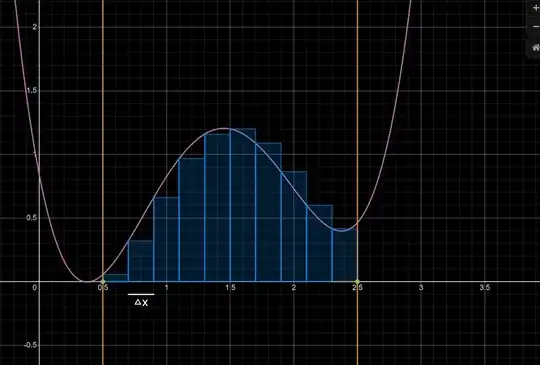After reading some of the comments and from outside help I've been made aware that my notation may have been the problem. So I'm rewriting this with a new set of questions with better notation and hopefully better understanding.
Let me start from the very beginning - Limits: $\lim_{x\to a} x$ refers to making x very small and almost $a$ but $x\ne a$
The next thing is derivation. Derivative of $f(x)$ if the limit exists refers to the new function $f'(x)$ whose each input $x$ maps to $f$ and output is the slope at that point in the $f$. In other words, the ratio of infinitely small change in $y$ when infinitely small change happens to input $x$ for every point. Mathematically,
$$ \lim_{\triangle x \to 0}\frac{f(x + \triangle x) - f(x)}{\triangle x} $$
Indefinite integral in simpler words is just the opposite of derivative. If the derivative of $f(x)$ is $f'(x)$ then the integral of $f'(x)$ is $f(x) + C$ where $C$ can be any constant which is shown by pushing the curve up or down the slope doesn't change so all $C$ would make the derivative same as $f'(x)$
$$ \int f'(x) = f(x) + C \ \ \ \ \& \ \ \ \ \frac{\mathrm{d}f(x)}{\mathrm{d}x} = f'(x)$$
Problem come in Definate Intregal. To my understanding Definite integral is integral between fixed range $[\alpha, \beta]$ given function is continuous. This solves our problem of $C$ constant as per how it is calculated. According to Theoram:
$$ \int_\alpha^\beta f'(x) = f(\beta) - f(\alpha) $$
which makes sense as:
$$ \begin{align} & \ \ \ \ \ (f(\beta) + C) - (f(\alpha) + C) \\ &= f(\beta) - f(\alpha) + (C-C) \\ &= f(\beta) - f(\alpha) \end{align} $$
Q1. But why is it $f(\beta) - f(\alpha)$ in the first place?
Now I would also want to talk about Area. To get the Area of the curve we divide it into little rectangles with the width of $\triangle x$ which tends to 0 bur $\triangle x \ne 0$
Mathematically area will be:
$$ A() = \lim_{\triangle x \to 0} \triangle x \sum_{i=\alpha}^\beta f(x_i + (i-1)\triangle x) $$
Since from pic $\alpha = 0.5\ \ \beta = 2.5$ the above equation is:
$$ A() = \lim_{\triangle x \to 0} \triangle x \sum_{i=0.5}^{2.5} f(x_i + (i-1)\triangle x) $$
This equation by definition of integration is:
$$ \int_{\alpha}^\beta f(x) \triangle x $$
Now Fundamental Theorem of Calculus says
$$ \int_{\alpha}^\beta f(x) \triangle x = F(\beta) - F(\alpha),\ \ F'(x) = f(x) $$
Q2 - 3:
Q2. What is the relation of Area to antiderivative function?
Q3. How one thus comes to the logic of Subtracting from a geometrical perspective, here above image.
